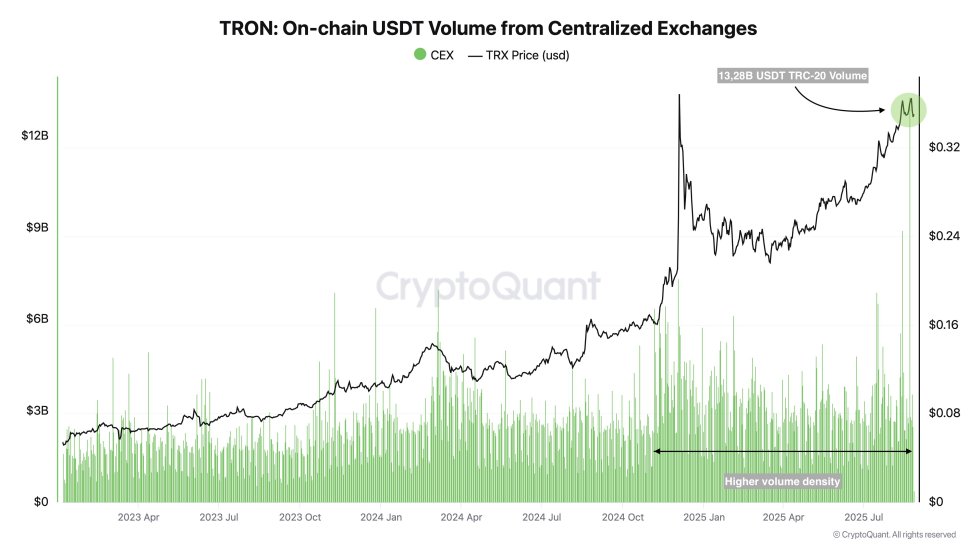TRON (TRX) has experienced heightened volatility over the past two weeks after reaching multi-year highs, but bulls continue to defend key support levels. Despite short-term price swings, the network’s fundamentals remain strong, reinforcing investor confidence in its long-term trajectory. Analysts point out that Tron’s resilience is supported not only by technical structure but also by robust on-chain activity that sets it apart from competitors.
Top analyst Darkfost recently highlighted striking data: TRC-20 USDT flows from centralized exchanges have reached historic highs, signaling unprecedented demand for stablecoin transactions on Tron. This surge underscores the network’s growing role as one of the primary blockchains for USDT usage. Its appeal lies in the ecosystem of services and products built on top of it, coupled with Tron’s ability to deliver consistently low fees and rapid execution.
This combination has attracted both retail investors and institutions, positioning Tron as a critical infrastructure layer in the stablecoin economy. As volatility tests market sentiment, the rising reliance on Tron for USDT transfers highlights a deeper narrative—beyond price action, adoption continues to accelerate. For many, this growing utility signals that Tron’s strength extends well beyond short-term market fluctuations.
Tron Strengthens Its Role As Leading Blockchain For USDT
According to top analyst Darkfost, one of the clearest signs of Tron’s strength is the accelerating adoption of TRC-20 USDT across centralized exchanges. More and more platforms have integrated Tron-based stablecoin transfers, reflecting genuine investor demand. This trend has been especially evident since late 2024, when the density of on-chain volume originating from exchanges began to rise significantly, signaling deeper reliance on Tron’s infrastructure.
The scale of this activity became undeniable on August 22, when over $13 billion worth of USDT flowed on-chain from centralized exchanges in a single day. This marked the third-largest daily USDT volume ever recorded on the blockchain, underlining just how central Tron has become in global stablecoin settlement.
A closer look at the data reveals that Binance dominates this activity, representing more than 65% of TRC-20 USDT transfers among major exchanges. HTX follows with 18%, while Bybit accounts for another 5%. Together, these flows illustrate how major industry players lean heavily on Tron’s network to process massive amounts of stablecoin liquidity.
TRX Holds Key Support As Bulls Defend Uptrend
TRX is trading around $0.348 after a volatile pullback from recent highs near $0.37. The 4-hour chart shows price dipping sharply but finding support at the 200-day moving average around $0.342, where buyers stepped in to defend the trend. This bounce suggests that while momentum has cooled, the broader uptrend remains intact as long as TRX holds above this critical zone.
Currently, TRX is consolidating between the 50-day moving average at $0.354 and the 200-day support, forming a tight range that signals indecision in the market. Bulls must reclaim the 50-day and 100-day averages, clustered around $0.354–$0.356, to shift momentum back in their favor. A breakout above this level could open the door for a retest of $0.36 and eventually $0.37, which remains the key resistance that capped the last rally.
Failing to hold the 200-day average would weaken the structure and expose TRX to further declines, with the next support near $0.335. For now, the chart reflects cautious optimism: buyers continue to defend higher lows, but reclaiming short-term moving averages will be essential for TRX to regain strength and push toward new highs.
Featured image from Dall-E, chart from TradingView

